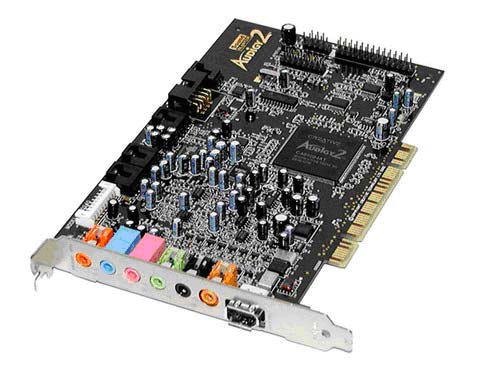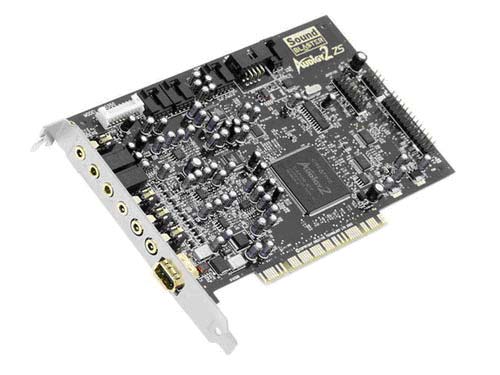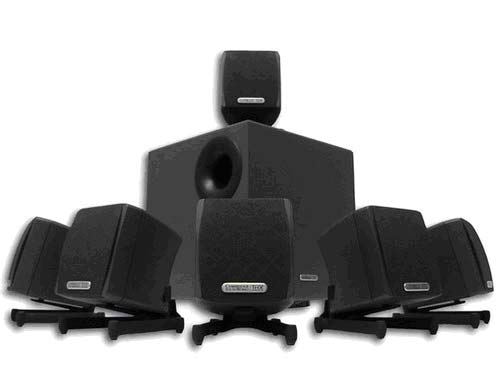Buyer's Guide: High End System - May 2004
by Wesley Fink on May 26, 2004 11:00 AM EST- Posted in
- Guides
Sound Card
Recommendation: Creative Labs Sound Blaster Audigy 2 (6.1) OEMPrice: $71

Since many of the packages that come with sound cards add a lot to the cost and little to the value, an OEM version of an Audigy 2 sound card provides the best value for a high-end sound card. If you're a big gamer, love watching movies, or are just someone who wants quality sound, the Audigy 2 is one of the best on the market to fit those needs. This version of the Audigy 2 supports 6 channels of sound and will deliver a great listening experience in any game, and especially ones that support the Audigy 2's special features like EAX. Simply pair the Audigy 2 with the right set of speakers and you'll have the necessary tools for an exceptional listening experience. Other special Audigy 2 features include 24/96 analog playback and recording and "add-ons" like FireWire.
Alternative: Creative Labs Sound Blaster Audigy 2 ZS (7.1) retail
Price: $83

The Audigy 2 ZS differs from the regular OEM Audigy 2 mainly in its support of 7.1 channels of sound instead of 6.1 The benefit of going to 7.1 isn't really all that huge, as there's a point that you reach where continually adding more channels yields diminishing returns; that is, your surround sound experience doesn't get a whole lot better going from 6.1 to 7.1 channels, or for that matter, 5.1 to 7.1 channels, depending on how sensitive your ears are. The Audigy 2 ZS is also a retail package instead of OEM, meaning you get additional bundled features, such as video games and a FireWire header.
As we've said before, there are inevitably going to be people who don't need this kind of audio processing power. For those users, we simply suggest that you use your motherboard's onboard sound controller. Some people could care less about their system's sound as long as there isn't any interference or crackling. If that description fits you to a tee, then use the onboard sound controller and forget about the Audigy 2.
Speakers
Recommendation: Logitech Z5300 THX Certified 5.1 speakersPrice: $146 shipped

Logitech, yet again, tops our speaker recommendation this week with their popular Z5300 5.1 THX Certified speaker system. Besides obviously supporting 5.1 channels of sound, the Z5300 is able to boast such features as a 100W subwoofer and a greater than 85 dB signal to noise ratio. The surround sound gaming and movie experience is tremendous, especially paired with a good Audigy 2 sound card. These speakers can also get impressively loud, and best of all, we didn't encounter any sort of crackling or distortion as volume was turned up to excruciatingly loud levels. For the price, these speakers are unbeatable.
Alternative: Creative Labs Megaworks THX Certified 6.1 speakers
Price: $248 shipped

This speaker system justifies its value versus the Logitech Z5300 speakers with:
- 6.1 surround sound instead of 5.1 surround;
- 99 dB signal to noise ratio instead of "somewhere" over 85 dB;
- 150W subwoofer instead of 100W subwoofer;
- 70W per satellite and 75W for the center instead of 35W and 39W center; and,
- Positional audio support.
If, for whatever reason, you're not interested in high end sound and will be gaming or watching movies mostly with your headphones on, obviously an expensive surround sound system will be pretty useless. If that's the case, you may just want to opt for 2.0 or 2.1 speakers, such as the ones recommended in our last Entry Level Buyer's Guide.
If you cannot find the lowest prices on the products that we've recommended on this page, it's because we don't list some of them in our RealTime pricing engine. Until we do, we suggest that you do an independent search online at the various vendors' web sites. Just pick and choose where you want to buy your products by looking for a vendor located under the "Vendor" heading.










59 Comments
View All Comments
roostercrows - Friday, May 28, 2004 - link
The article was excellent, thank you Wesley, and considering all the informed comments it received I'm not alone in looking forward to reading more of them. Not to add yet another category to what must already be a lot of work for you guys but is there somewhere I could see the entire dual processor systems that have been suggested by some advanced members, after they are built and running of course, including performance/prices and why they feel they have assembled a better "bang for the buck" high-end system?roostercrows - Friday, May 28, 2004 - link
Sparkywonderchicken - Friday, May 28, 2004 - link
Sorry I hit send too fast. I have heard many complaints about DVD-R burning from these units.Ma10n3 - Friday, May 28, 2004 - link
I agree with #44--A high-end system and an overclocking rig should not be classified as the same.Sparkywonderchicken - Friday, May 28, 2004 - link
Don't you mean NuTech DDW-082?? for the DVD??bigtoe33 - Friday, May 28, 2004 - link
Overclocking is mainly about what boards and cpu's will do the high fsb's, also what is the most bang per buck as overclockers mainly buy cheap and clock up to gain the speed.I would expect Wesley will show some 300+fsb action on A64 as well as the cheap 2.4a prescott running 180fsb+....these are things you will find on an overclocking rig and not a high end ;-)
azndelite6983 - Friday, May 28, 2004 - link
Thanks for the response, Wesley. I appreciate that you guys do these guides at all, considering the monumental task of trying to keep up with new hardware.What I don't quite understand is that any high-end system would be a terrific overclocking possibility, and although u supposedly have a different guide for that, it might be nice to see some suggestions on oc settings for the high-end system as well as possible mods (cooling mostly). I'm not sure I see the necessity of having an "overclocking system" when the parts remain very close to the high-end system. Also the fact that anyone willing to spend anywhere close to $5000 on a computer should really know what they are doing, but may want some advice on how to get the most out of their already quick setup.
markz - Friday, May 28, 2004 - link
I agree with #40.That is all.
Ma10n3 - Friday, May 28, 2004 - link
To correct what I said in #39, more games support SMP now than I had previously thought...Link for FAQ:
http://home.swbell.net/m3tech/hard/smp_games.html
Murst - Friday, May 28, 2004 - link
Wesley & Evan,First of all, thanks for the guides (this is my favorite part of anandtech and its probably the reason why I've been visiting this site more than any other lately). I do have some reccomendations, however.
It seems to me that your definitions of low/mid/high are rather difficult to understand. It actually kind of reminds me of intel's new naming policy. Why use words that don't really mean anything when you can give numbers which are descriptive? Here is an exmaple of what I'm thinking (my goal is clarity).
-------------------------------------------
Old name: New name:
entry-level System for under $800
mid-range System for under $1500
high-range System for under $2500
.......... System for under $4000
-------------------------------------------
I think this would make your goals in these articles much more clear, as people would understand exactly what goes into making the decisions. Also, my numbers may not be accurate, as I don't have much experience with pricing systems.
Overall, good work on this article, and I do believe that it is much closer to what "I" believe is a high-end system as compared to the last article.
I'll be looking forward to the next system reccomendations, especially to what 939 will bring.